4
TRANSPORTATION AND SAFETY
Transportation Occurrences
Record lows in the number of occurrences in aviation and on
the road made 1999 a particularly successful year in transportation
safety. This was despite marginal increases in the rail and marine
sectors. The aviation sector saw the fewest accidents involving
Canadian-registered aircraft in the last 25 years, at 340. Likewise,
road collisions also represented the lowest number during this
period, at 150,919 in 1998. While the number of marine accidents
was up marginally, seven per cent over 1998, it was still
16 per cent below the five-year average. The number
of rail accidents was also up slightly over 1998 levels,
five per cent, yet remained below the comparable five-year average
by six per cent. Despite these increases in rail
and marine occurrences, the overall accident rate continued its
downward trend.
These somewhat mixed results in terms of accidents/collisions
were tempered by the fact that the number of fatalities fell significantly
in each of the four major modes. Fatalities in air, marine
and road each registered double-digit reductions from the
five-year average of 20, 17 and 11 per cent, respectively, while
rail fatalities were down six per cent. Overall, fatalities were
11 per cent lower than the five-year average.
These comparisons can be misleading, however, as they do not
take into account the specifics of each mode, nor do they reflect
the level of activity or exposure to risk associated with each.
Table 4-1 compares the most recent statistics on transportation
occurrences by mode with the five-year average.
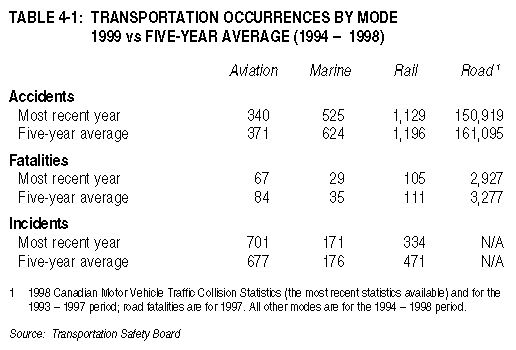
The accident rates shown for 1999, which attempt to take into
account the level of activity in each mode, continued either to
exhibit a general downward trend or were consistent with the five-year
average. (Reliable activity measures for motor vehicles are not
available.) While the accident rate for aviation was more than
one full point below the five-year average (1.3), those for marine
and rail were consistent with the five-year trend.
Table 4-2 compares accident and fatality rates by mode for
1999 with the five-year average.
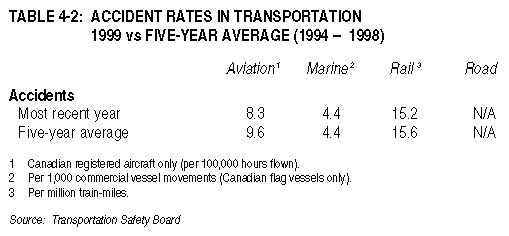
These aggregate measures of activity are intended to provide
a point of reference in interpreting the occurrence statistics;
however, each has its inherent limitations. In rail, for example,
the measure of train-miles captures only that activity that occurs
on main-track lines and does not extend to yards, spurs and sidings.
Since roughly half the rail occurrences take place on non-main
track areas, this tends to overstate the actual accident rate.
Similarly for marine, measures of trip movements and vessel movements
do not directly take into account the overall distance travelled.
Accident rates for aviation can vary significantly whether measured
through flying hours, aircraft movements or licences.
Figure 4-1 shows the number of transportation of dangerous
goods reportable accidents for the period 1990 to 1999.

Rail
Domestic Operations
The statistics presented in this section include all railways
under federal jurisdiction.Note 1
There were 1,129 rail-related accidents reported to the Transportation
Safety Board in 1999. While this was up five per cent from the
1998 total of 1,076, it was still a decrease of six per cent from
the five-year average of 1,197. The increase in the number of
accidents, coupled with a marginal decrease in total train-miles,
was reflected in a higher accident rate per million train-miles
in 1999 of 15.2 over the 1998 rate of 14.3. Nonetheless,
it was slightly better than the rate for the 1994 - 1998 five-year
average of 15.6.
With the exception of main-track and non-main-track collisions,
all accident types contributed to the increase in 1999. Of the
total rail-related accidents, non-main-track train derailments
accounted for the largest portion, with 36 per cent. Crossing
accidents followed at 25 per cent and main-track train derailments
at 11 per cent. The increase in non-main-track train derailments
was mainly attributable to accidents involving single-car
derailments in a yard, spur or siding, occurring at relatively
slow speeds and with a low associated public risk.
Approximately 50 per cent of all main-track train derailments
in 1999 resulted in either one or two cars derailing, and 12 per
cent involved dangerous goods. Accidents involving a dangerous
goods product represented 20 per cent of the total rail accidents
in 1999, down seven per cent from the previous five-year average.
The number of accidents involving a release of dangerous goods
product remained at roughly one per cent of the total.
A total of 334 incidents was reported to the Transportation
Safety Board in 1999, down 24 per cent from the 440 reported in
1998, and down 29 per cent from the five-year average of 471.
The majority of these incidents (50 per cent) involved dangerous
goods cars leaking a product, but not as a result of an accident.
Table 4-3 summarizes rail accidents reported for the five-year
period 1995 - 1999.
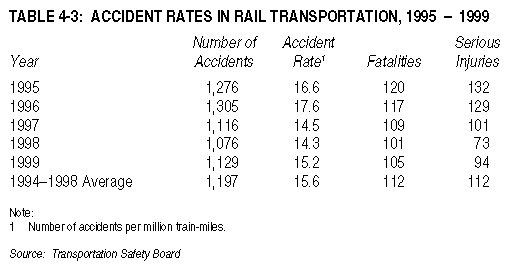
In 1999, 105 people were fatally injured in rail-related accidents,
up from 101 in 1998 but down from the five-year average of 112.
The 1999 total of 97 fatal accidents represented a slight decline
from the 1998 total of 98 and was below the five-year average
of 103. The majority of the fatalities (93 per cent) were related
to accidents involving trespassers (58 per cent) or associated
with rail grade crossing accidents (35 per cent). The number of
crossing accidents involving passenger trains remained relatively
consistent in 1999 compared with the five-year average. Transport
Canada, in partnership with its stakeholders, has several programs
to address these safety concerns. Direction 2006, for example,
is a major initiative aimed at reducing the number of trespasser
and crossing fatalities by 50 per cent by the target year.
There was a total of 282 crossing accidents in 1999, a three
per cent increase from the 1998 total of 273. The 1999 total remained
well below the five-year average of 343. Although the number
of rail-crossing accidents increased in 1999, that of fatalities
and serious injuries was slightly lower than in the previous
year and considerably lower than the five-year average.
Table 4-4 shows the number of railway crossing accidents by
province from 1995 to 1999.

The number of crossing accidents at automated crossings remained
relatively constant at 45 per cent of the total crossing accidents
in 1999. Although automated crossings accounted for the largest
portion, this form of protection is generally in areas with relatively
high motor vehicle traffic. The increase in 1999 can be attributed
in part to crossing accidents occurring at non-automated farm
crossings, where the number of accidents doubled to 10 in 1999
from five in 1998.
Table 4-5 summarizes trespasser accidents by province from
1995 to 1999.

The number of trespasser accidents rose to 94 in 1999 from
78 in 1998, but remained well below the five-year average of 103.
The majority of these accidents occurred in the Ontario and Quebec,
49 and 28 per cent, respectively. The number of fatal trespasser
accidents remained relatively constant at 60, slightly below the
five-year average of 62. Two thirds of all rail-related fatal
accidents were a result of trespasser accidents, a consistent
ratio during the past five years.
Through public awareness and education programs, monitoring
and enforcement, safety programs and research, Transport Canada
will continue to address the issues related to reducing accidents.
In additional to Direction 2006, Transport Canada also continues
to support the Operation Lifesaver Program, which focuses on education
and public awareness.
Figure 4-2 plots the number of crossing and trespasser accidents
since the launch of the Direction 2006 initiative in 1996. Significant
reductions were achieved (particularly in grade crossing accidents)
in the period immediately following the launch; the trend has
slowed more recently, however.

Two rail accidents in 1999 warranted particular attention.
The first occurred in Thamesville, Ontario, where a VIA passenger
train collided with stationary rail cars containing dangerous
goods products. Two employees were fatally injured, and some train
passengers suffered injuries.
The second occurred in St. Hilaire, Quebec, where 33 cars
of a CN train carrying petroleum products derailed. A second
CN freight train struck the derailed cars, which were obstructing
their way, with a resultant 26 additional cars and two locomotives
also derailing. Two crew members sustained fatal injuries
and fires and explosions were reported. In addition, 350 people
from the town of St. Hilaire were evacuated because of heavy smoke.
Road
The most recent annual data on motor vehicle traffic collision
statistics is 1998 for fatalities, injuries and casualty collisions
and 1997 for property damage only collisions.
Domestic Operations
Canada's road safety record has continued to improve steadily
over the last several decades. In 1998, there were 2,927 fatalities
resulting from motor vehicle accidents, the lowest annual total
in 43 years. (Statistics of this nature have been recorded since
1945.) The number of road-related fatalities was down 4.5 per
cent from 1997 and was significantly below (10.7 per cent) the
1993-1997 average.
Table 4-6 gives the national number of road-related casualty
collisions, fatalities and injuries from 1993 to 1998.

Casualty collisions include all reportable motor vehicle accidents
that result in a fatality or an injury. The steady downward progression
has continued, with the national total falling 1.2 per cent from
1997 and 7.9 per cent from the 1993-1997 five-year average.
The number of fatalities also declined in 1998, standing
at 4.5 per cent below the 1997 level and 10.7 per cent below
the comparable five-year average.
Table 4-7 shows the number of road fatalities in Canada classified
by six major types of road users.
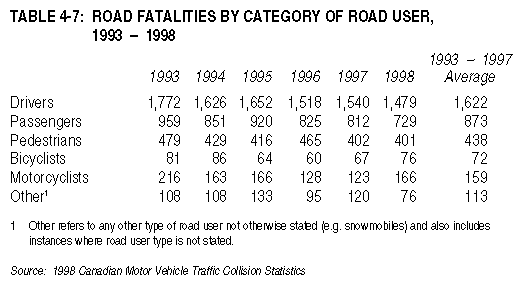
All categories, with the exception of bicyclists and motorcyclists,
contributed to the continued overall decline in fatalities between
1993 and 1998. The category "drivers," which represents
the single largest segment of the road user population, also accounts
for the largest share of road fatalities. In 1998, this category
of road user accounted for 51 per cent of total road fatalities,
while "passengers" and "pedestrians" accounted
for 25 per cent and 14 per cent, respectively.
From 1996 to 1998, the highest fatality rates in Canada were
in the Northwest Territories and the Yukon, reflecting the relatively
low number of vehicles registered in those territories and the
more difficult driving conditions. Ontario, with the largest road
network and the highest number of vehicle registrations, continued
to have one of the lowest fatality rates during this period
at 1.4 per 10,000 vehicles registered, behind Newfoundland
at 1.2.
Figure 4-3 compares road fatality rates by province from 1996
to 1998.

From 1990 to 1997, vehicles involved in collisions with commercial
vehicles accounted for approximately eight per cent
of all vehicles involved in road collisions, yet accounted for
roughly 18.6 per cent of all road fatalities. The number of fatalities
resulting from collisions involving commercial vehicles increased
slightly in 1997 over the previous year due, in large part, to
the single vehicle/bus collision at Les Eboulements, Quebec, in
October of that year. Figure 4-4 shows the percentage of road
collisions and fatalities involving commercial vehicles from 1990
to 1997.Note
2
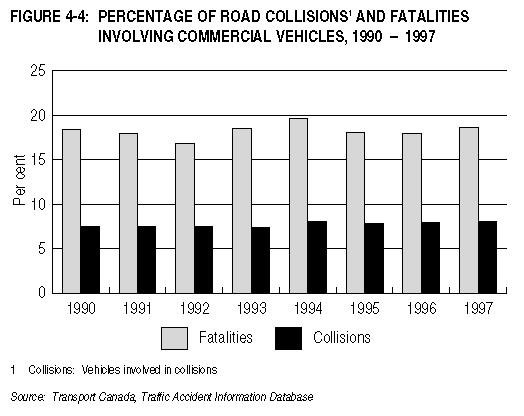
Table 4-8 gives a breakdown of commercial and other vehicles
involved in fatal collisions by type of vehicle from 1993
to 1997.

In 1997, private automobiles accounted for 53 per cent of vehicles
involved in fatal collisions. This share was down slightly from
that of 1993, when the automobile accounted for 56 per cent. Light
duty trucks and vans had the second largest share of vehicles
involved in fatal collisions in 1997, with 25 per cent, followed
by the combined categories of Truck (Tractor Trailer, Trucks less than
4,536 kg and other) with 13 per cent.
Table 4-9 compares the number of vehicles involved in fatal
motor vehicle collisions by type of vehicle from 1993 to
1997.

International Comparisons
As a result of its continuing successes in improving motor
vehicle safety, Canada ranks as one of the top Organization for
Economic Co-operation and Development (OECD) member countries
that are comparable.
Figure 4-5 compares fatality rates per motor vehicles registered
for selected OECD member countries from 1996 to 1998.
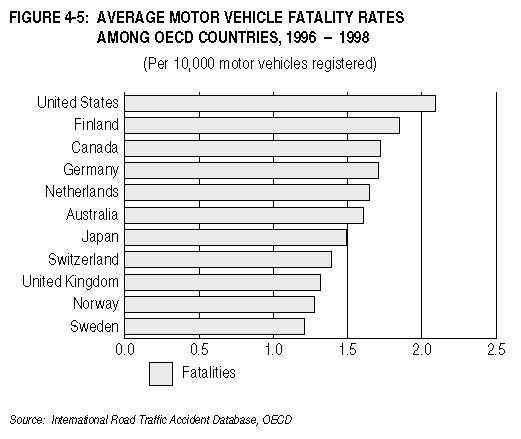
Vehicle ownership rates are considered to be an indicator of
motor vehicle activity and exposure to risk. Canada's vehicle
ownership rate was 58 per 100 inhabitants in 1997, compared with
76 in the United States, which has the highest among OECD countries.
Higher ownership rates in Canada and the United States indicate
a greater degree of reliance on this mode of transportation and
therefore a generally higher exposure to risk for road users.
Marine
Overview
There were 525 shipping accidents in 1999, up seven per cent
from 1998 but 16 per cent below the
1994 - 1998 five-year average, and approximately half the 1990
total. Over the past decade, there has been an average annual
decline in shipping accidents of seven per cent. This decline
has been relatively steady, with increases recorded in only three
years, 1990, 1994 and 1999. In both 1990 and 1994, the largest
increase was in the number of flooding accidents; in 1999, the
greatest upturn was in the number of groundings (143), propeller/rudder/structural
damage (40) and collision (24) accidents. These increases were
largely attributable to fishing vessels.
As in preceding years, the largest proportions of shipping
accidents in 1999 by type of accident were in the categories grounding
at 27 per cent, followed by striking at 15 per cent, fire/explosion
at 13 per cent and flooding at 12 per cent. The number of
capsizing accidents (seven) declined notably in 1999, representing
roughly half the 1998 total and one third of the five-year average.
A total of 573 vessels were involved in shipping accidents
in 1999. Fishing vessels accounted for 280, or 49 per cent,
of these, consistent with historical trends. This total for
fishing vessels did, however, represent a 11 per cent increase
from 1998. As in previous years, the majority of these vessels
were involved in grounding and flooding accidents, at 28 and 20
per cent, respectively.
The proportion of commercial vessels involved in accidents
in 1999, 39 per cent, was on a par with the previous five-year
average. There were 225 vessels involved, one per cent below the
1998 total and 19 per cent below the five-year average. Of those
vessels that pose a greater risk to persons and the environment,
ferry (22 vessels in 1999) and passenger (18 vessels) remained
comparable with their respective five-year averages, while tanker
vessels (14) showed a modest decrease. The one notable increase
over 1998 was in the number of accidents involving barge vessels
(36), up 33 per cent in 1999 but still on a par with the five-year
average. The largest decrease in recent years has been in the
number of accidents involving vessels in the bulk carrier/oil,
bulk, ore (OBO) category, with 67 reported in 1999, compared with
the five-year average of 97. Striking accidents and grounding
accidents were the most common type reported for commercial vessels,
at 28 and 22 per cent, respectively.
In 1999, there were 69 accidents involving vessels in other
categories (i.e. service, non-commercial and other), 23 per cent
over the 1998 total and nine per cent above the five-year average.
Service vessels accounted for the single largest component, with
almost 51 per cent.
Figure 4-6 shows the number of vessels involved in shipping
accidents by vessel type from 1994 to 1999.
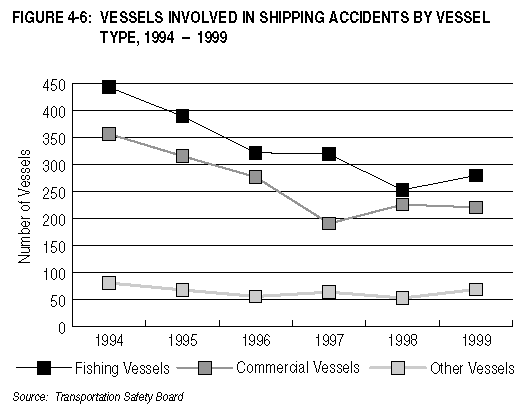
In 1999, there were 84 foreign-flag vessels involved in shipping
accidents, down slightly from the 1998 total of 87 but 30 per
cent below the five-year average of 120. Bulk carrier/OBO
was the most common vessel type at 45 per cent. The majority
of shipping accidents involving foreign-flag vessels involved
striking, at 33 per cent, and groundings, at 25 per cent. The
Laurentian Region reported the greatest number of foreign-flag
vessels involved in shipping accidents, with 26, followed by the
Western Region, with 23.
In addition to shipping accidents, there were 69 accidents
aboard ship in 1999, up 14 per cent from the 1998 total of 59
and 13 per cent from the 1994-1998 average of 60. The majority
of these accidents, 43 per cent, occurred on commercial vessels,
while 37 per cent occurred on fishing vessels. The Maritimes Region
reported the largest increase, up 35 per cent over the five-year
average, and represented one quarter of the total, the same share
held by the Western Region.
There were 29 marine-related fatalities in 1999, down from
48 in 1998 and below the five-year average of 35. Approximately
half (15) of the casualties resulted from accidents aboard ship.
Of the 29 fatalities, 14 were on a fishing vessel, eight on a
commercial vessel and seven on a non-commercial vessel. Only two
marine accidents resulted in multiple casualties. In one, a collision
between a pleasure craft and a tug towing a barge on the West
Coast resulted in five fatalities; in the other, a charter fishing
boat in the Laurentian Region foundered with the loss of three
lives.
Forty one vessels were lost in 1999, down 16 per cent from
1998 and 40 per cent from the five-year average. Vessels of less
than 150 gross registered tonnage accounted for the largest proportion
(93 per cent) of those lost vessels in 1999. Most were small fishing
vessels.
The number of shipping incidents in 1999 (171) was consistent
with the total for the previous five-year average of 176. The
most common, 41 per cent, were related to engine/rudder/propeller
problems. The greatest reduction in the longer-term trend has
been in the number of close-quarters situations reported. In 1999,
this type of incident represented 19 per cent of the total, still
well below the five-year average of 29 per cent.
Table 4-10 shows marine occurrences by type from 1994 to
1999.
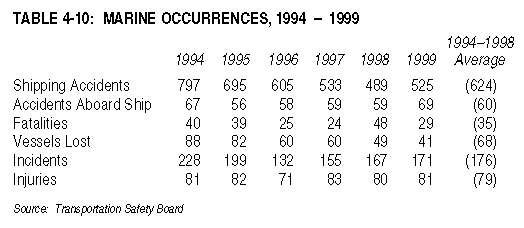
Regional Overview
The Transportation Safety Board (TSB) defines six regional
boundaries for occurrence reporting purposes. Accidents occurring
in foreign waters involving Canadian vessels are also captured
as part of the regular statistical occurrence reporting.
The Western Region, which has routinely reported the single
largest regional total of shipping accidents (167 in 1999), registered
the largest decrease from 1998 levels, with a 14 per cent decline.
Shipping accidents in this region have been decreasing since 1994,
when the total was 300. The decline has been largely attributed
to the number of fishing vessels involved. Vessels lost in this
region in 1999 represented 39 per cent of the national total.
Conversely, the trend for the Maritimes Region, which had been
declining since 1994, showed a 26 per cent increase in shipping
accidents over 1998. The increase was seen mostly in the number
of accidents involving fishing vessels, up to 92 in 1999 from
60 in 1998. The greatest percentage of fishing vessel accidents
was due to grounding and flooding, at 24 and 23 per cent, respectively.
Vessel losses that occurred in this region accounted for approximately
27 per cent of the national total.
The largest year-over-year increase in 1999 occurred in the
Newfoundland Region. The number of shipping accidents there rose
by 38 per cent from 1998 to 95, a 35 per cent increase
from the five-year average. Of the 103 vessels involved,
74 per cent were fishing vessels, up 36 per cent from 1998.
The leading categories amongst fishing vessel accidents were fire/explosion
at 20 per cent, propeller/rudder/structural damage at 19 per cent
and flooding at 18 per cent. The number of vessel losses occurring
in this region represented about one quarter of the national
total.
In 1999, there were 67 shipping accidents in the Laurentian
Region, up four per cent from 1998. Much of the increase was due
to a rise in the number of accidents involving tug/barge vessels
(15), up from six in 1998 and from 12 for the five-year average.
In addition, there were 25 grounding accidents, twice as many
as in 1998. Commercial vessels were involved in 76 per cent of
these grounding accidents for the Laurentian Region.
The Central Region reported 50 shipping accidents, a 21 per
cent decrease from the previous year's total. Fewer accidents
involving ferry/passenger vessels (five in 1999, 13 in 1998)
were behind this overall decline.
The Arctic Region saw 15 vessels involved in shipping accidents,
three times the 1998 total of five and almost double the five-year
average of eight. The increase was attributed in large part to
accidents involving service type vessels.
Figure 4-7 compares the percentage share of shipping accidents
by Transportation Safety Board regions for 1999.
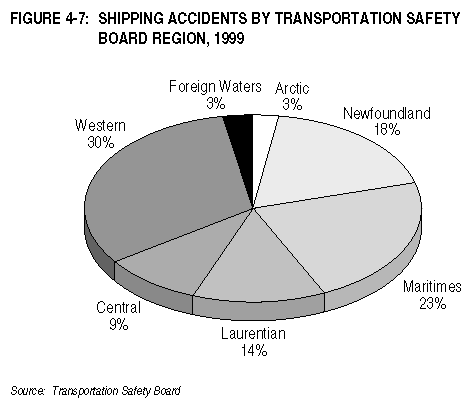
Commercial Shipping Activity
In terms of the level of shipping activity, the estimatedNote
3 number of vessel trips for Canadian commercial vessels
in 1999 has decreased by four per cent from 1998, whereas the
number of vessels involved (154), remained equivalent. Foreign-flag
vessel trips are estimated to have declined by 11 per cent
from 1998, while the number of vessels involved (71) was
on par with the 1998 total. When comparing accident ratesNote 4 for Canadian
and foreign vessels over the same period, it is important to recognize
that included in Canadian commercial vessels are the daily operations
of numerous tugs and barges, whereas foreign-flag vessels mainly
comprised larger vessels such as tankers, bulk carriers and container
vessels. This incongruity contributes to a generally lower accident
rate for foreign-flag vessels. Canadian commercial fishing vessel
activity was estimated to have increased by 14 per cent
in 1999.
Figure 4-8 charts the accident rate of Canadian-flag and foreign-flag
commercial vessels from 1994 to 1999.

Port State Control
Canada is signatory to two Memoranda of Understanding (MOU)
on Port State Control: the Paris MOU, which includes 18 European
countries as well as Canada, and the Tokyo MOU, which comprises
18 Asia-Pacific countries and Canada. Members of the Paris MOU
are required to obtain an inspection rate of 25 per cent of vessels
entering the members' ports. Members of the Tokyo MOU are working
toward a regional percentage of individual vessels at 50
per cent of vessels entering the region's member ports.
In 1999, in Canada, 1,078 inspections were carried out under
these MOUs on vessels from 57 different flags of registry. Of
the vessels inspected, 52 per cent were found to have defects,
and of these, 22 per cent were serious enough to require the vessels
to be detained. Most detentions issued in Canada were issued under
three categories of offences: lifesaving equipment, firefighting
equipment and structural defects. The majority of vessels inspected,
44 per cent, were bulk carriers, with 17 per cent of these being
detained. The average age of detained vessels was 16.5 years.
In 1999, there were seven Canadian vessels inspected in foreign
ports that are signatory to the Paris MOU. They were found to
have deficiencies and two were detained. Of the vessels inspected,
there were five supply ships, one passenger ship and one special
purpose vessel. As for the defects leading to detention, for the
passenger ship, its detention was related to its oil record book
and oily water separating equipment while the supply ship, certification
issues tied to minimum safe manning, oil pollution prevention
and cargo ship safety radio were behind its detention.
Recreational Boating
In 1997, the most recent year for which data is available, there
were 138 drowningsNote 5 from recreational boating in
Canada. This is a 12 per cent decline from the previous year's
total and a three per cent drop from the 1992 - 1996
five-year average of 143. At 33 per cent, fishing accounted for
the largest proportion of drownings from recreational boating;
this was consistent with 1996. At 43, drownings as a result of
powerboating showed a marked increase over the 1996 total of 30.
Ontario reported the largest percentage of drownings from recreational
boating, with 30 per cent, followed by Atlantic and Quebec, both
at 20 per cent. There were no recreational boating drownings in
the Northwest Territories or the Yukon in 1997, down significantly
from the 1996 total of 11.
The number of non-drowning boating fatalities dropped to 16
in 1997 from 20 in 1996. Of these, 11 involved collision/trauma
and five were the result of immersion hypothermia. In 1997, nearly
half the fatalities for both these incident types occurred in
British Columbia.
Aviation
Domestic Operations
This section summarizes the aviation occurrences involving
Canadian-registered aircraft. It does not include occurrences
involving foreign aircraft, nor does it include occurrences involving
ultra-light or advanced ultra-light aircraft.
In 1999, there were 340 accidents involving Canadian-registered
aircraft, down 12 per cent from the 1998 total of 385,
and eight per cent lower than the 1994 - 1998 five-year average
of 371. The 1999 total represents the lowest annual number of
aviation accidents involving Canadian-registered aircraft in the
last 25 years. Table 4-11 shows the number of accidents
and fatal accidents by type of aircraft from 1990 to 1999.
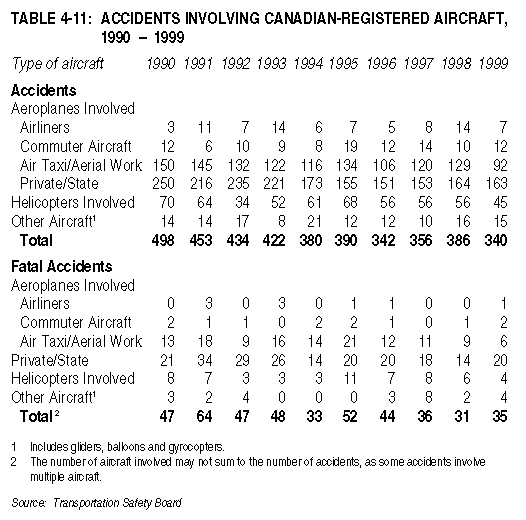
Over this ten-year period, the number of accidents for most
aircraft types declined significantly, most notably in the categories
of air taxi/aerial work and private aircraft. The number of accidents
involving helicopters also decreased substantially. Private/state
aircraft accounted for 48 per cent of the total number of
accidents, while air taxi/aerial work aircraft operations
accounted for 27 per cent. Although the number of accidents
involving private/state aircraft has been steadily decreasing over
time, this category has consistently represented nearly half the
total accidents involving Canadian-registered aircraft and, in
1999, accounted for roughly 57 per cent of the total of fatal
accidents.
Airliners include commercial aircraft that have a maximum take-off
weight of greater than 8,618 kilograms or aircraft that are authorized
to carry more than 20 passengers. In 1999, Canadian-registered
airliners were involved in seven accidents, down from 14 in the
previous year and from the 1994 - 1998 five-year average of eight.
One of these resulted in fatalities. In January, at Mayne Island,
British Columbia, a Kelowna Flightcraft aircraft collided with
terrain and had two fatalities.
Regional or large commuter aircraft are those having a maximum
take-off weight of less than 8,618 kilograms and capable of carrying
10 to 19 passengers/crew. In 1999, there were 12 accidents involving
aircraft in this type of operation, up slightly from the previous
year (10) but remaining in line with the five-year average of
13. In 1999, there were two fatal accidents involving
Canadian-registered commuter aircraft, each reported as collision
with terrain and each resulting in a single fatality. The first
occurred in March, at Davis Inlet, and involved a de Havilland
DHC6 departing Goose Bay with two crew on a VFR flight to Davis
Inlet. It was reported that weather conditions presented poor
visibility with blowing snow. The second took place in August,
at Sept-Îles, and involved a Beech 1900D that was travelling
from Port-Meunier to Sept-Îles. The pilot was fatally injured,
while the co-pilot suffered serious injuries on impact.
Most commercial air accidents involve aircraft in the air taxi/aerial
work categories. These types of operations accounted for 27 per
cent of the total number of accidents involving Canadian registered
aircraft, a decrease of 29 per cent from 1998 and 24
per cent from the 1994-1998 average. One fatal accident was
reported in 1999 involving an aerial application operation.
The accident rate in 1999 was 8.3 accidents per 100,000 hours
flown, below the both rate for 1998 and the five-year
average.
By region, the number of accidents continued to decrease in
1999 and to follow a downward trend for all regions over the 1990
- 1999 period. In 1999, the Prairie and Northern Region accounted
for 37 per cent of all accidents involving Canadian-registered
aircraft, followed by Ontario with 31 per cent and Quebec with
13 per cent. With the exception of the Ontario Region, which
remained unchanged over 1998 (105 accidents) and the Quebec
Region, which increased marginally (by two accidents), all regions
reported fewer accidents in 1999. The largest year-over-year
decrease occurred in the Pacific Region in 1999 - 1998, which
saw the number of accidents fall from 70 to 40, or 43 per cent.
Table 4-12 summarizes air accidents by region over the ten-year
period, while Table 4-13 shows the corresponding number of air
fatalities by region.

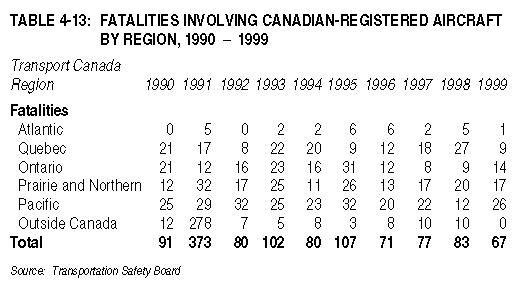
In 1999, air fatalities were down 19 per cent from both the
previous year and the 1994-1998 average. Although the Pacific
Region recorded the fewest number of accidents, it registered
the highest number of fatalities, with 26, followed by the Prairie
and Northern Region, with 17, and Ontario, with 14. There
were 43 serious injuries resulting from accidents, declining slightly
from the 1998 total of 48 and the five-year average of 49.
The number of reported incidents involving either a Canadian-
or foreign-registered aircraft decreased by ten per cent
from 1998 levels and was only 3.5 per cent more than the 1994
- 1998 average. All types of incidents contributed to the overall
decline in 1999. Loss of separation (which refers to an instance
in which less than the authorized minimum separation or distance
between two aircraft was not assured, and includes collisions
and risk of collision), declared emergencies, engine failures
and smoke/fire incidents were all down considerably.
International Comparisons
Table 4-14 compares the percentage of fatal air accidents involving
airliner and commuter aircraft for Canada and the US from 1994
to 1999.
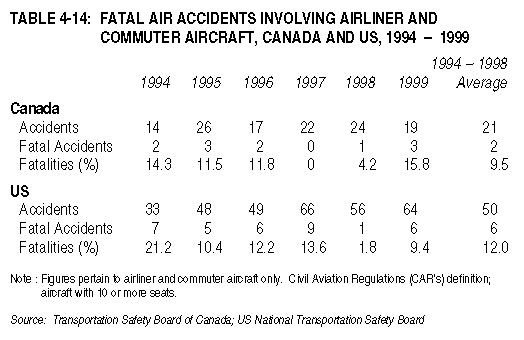
Comparing Canadian and US accident data is made difficult by
the fact that each country classifies and records its occurrence
data differently, and due to fundamental differences in the domestic
air network and infrastructure of each country. Canada's air transportation
network is largely linear in nature, extending the entire breadth
of the country; the US, on the other hand, uses a highly developed
hub and spoke network, fanning out in all directions. Both countries,
however, are members of international panels and working groups
whose goals are to establish a common taxonomy and to standardize
aviation safety related information. Work from such collaborative
efforts should greatly facilitate comparisons and understanding
of international safety records.
Based on the preliminary US aviation accident statistics for
1999, there was an increase in the number of American-registered
scheduled airlines flying under Part 121 Air CarriersNote 6 and Commuters.Note
7 Both accidents and fatal accidents for US-registered
aircraft were up, by eight and five per cent, respectively. At
64, US aviation accident totals for these categories were well
above the 1994 - 1998 five-year average of 50, while the total
for fatal accidents was consistent with the five-year average
of six.
From a safety perspective, using a rate of fatal accidents
per number of accidents as a rough means of comparison, Canada
had a slightly lower overall rate for the five-year period,
although year-to-year variations tend to fluctuate widely.
In terms of safety, 1998 was a banner year for the US air
industry, while Canada enjoyed its most successful year in
1999.
Transportation Occurrences
NOTES
1
Since the passage of the Canadian Transportation Act on
July 1, 1996, a growing number of federal rail lines have been
transferred to other operators that now report to provincial jurisdictions.
These provincial short-line operators now constitute upwards of
18 per cent of the total rail network in Canada.
|

